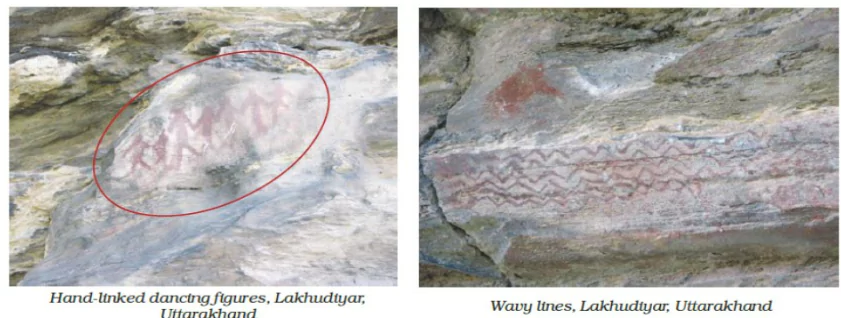Introduction
India boasts a rich legacy of rock paintings, including the Bhimbetka caves, Ajanta and Ellora caves, and Lakhudiyar rock shelters, showcasing diverse themes and artistic techniques from ancient times.
Lakhudiyar Rock Shelters

- Location: located along the River Suyal in the Kumaon Hills (Uttarakhand).
- Lakhudiyar translates to “one lakh caves.”
- Paintings in these shelters fall into three categories: Human figures, animals, and geometric patterns.
- Colours used include white, black, and red ochre.
- Predominant Scenes: Hand-linked dancing human figures which is a recurrent theme
- Superimposition of rock paintings with the earliest in black, followed by red ochre, and finally white paintings.
Narsinghgarh Prehistoric Paintings
- Location: located in Rajgarh district, Madhya Pradesh.
- Depicts spotted deer skins left out for drying, supporting the idea that early humans mastered the art of skin tanning for clothing and shelter.
- Some paintings portrayed musical instruments such as harps.
- Complex geometric shapes like spirals, rhomboids, and circles can be found.
Enroll now for UPSC Online Course
Jogimara and Sitabenga Caves
- Location: located in the Ramgarh hills, Chhattisgarh and contains paintings dated 1000 BC.
Ghodasar and Kohabaur rock art sites
- Location: located in Chhattisgarh.
- Site of Chitwa Dongri features a Chinese figure riding a donkey, images of dragons, and scenes of agriculture.
- Other Sites of Chhattisgarh: Limdariha, Oogdi and Sitalekhni.
- Early cave paintings in Odisha: Gudahandi Rock Shelter and Yogimatha Rock Shelter
Vishnudharmottara Purana
- The third khanda of the Vishnudharmottara Purana, a fifth-century text, includes the chapter Chitrasutra, a significant source of Indian art, especially painting.
- This text introduces the art of image-making known as “Pratima Lakshana”, which outlines the canons of painting.
Key Elements of Painting
- Vatsyayana listed six essential components of rock paintings in his book Kamasutra.
- The drama “Mudrarakshasa“ by Vishakhadutta discusses painting styles and their distinguishing features.
- Cauka Pitaka: Notable for individual framed drawings.
- Dighala Pitaka: Known for its extended scroll-style paintings.
- Yama Pitaka: Emphasizes standalone, isolated artworks.
Enroll now for UPSC Online Classes
Conclusion
- Prominent rock paintings of India stand as testament to the creative brilliance and cultural richness of ancient Indian Valley Civilizations, offering invaluable insights into the country’s artistic heritage and prehistoric past.
![]() April 12, 2024
April 12, 2024
![]() 1873
1873
![]() 0
0
